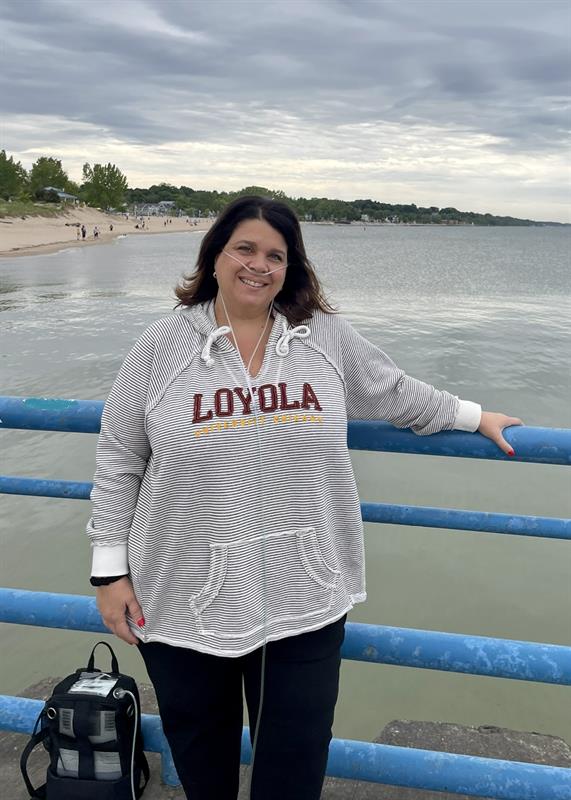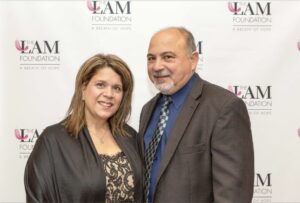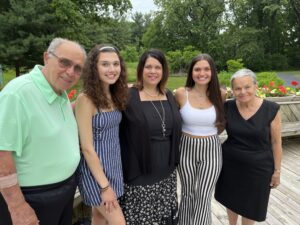Fighting for a LAM Diagnosis and Now a Cure

For seven years, I continually searched for answers because I knew something was wrong with my health. I had a hard time breathing and started coughing up blood clots with exertion or exercise. I went to several pulmonologists, but no one could find anything. On a family trip to Greece in 2014, I had a severe episode while swimming with my daughters. I couldn’t breathe, I became dizzy and almost passed out. I spent two days in bed without being able to move. The doctor there thought it was an asthma attack and gave me an inhaler. When I came back home, I had a CT scan and the report said everything was normal. I saw another pulmonologist and he said there’s nothing wrong…you just have to lose weight. With despair, I tried to explain that I still had these issues even when my weight was normal. How could I exercise when I couldn’t breathe and kept coughing up blood clots? I distinctly remember him saying, “I don’t know what to tell you…just lose weight.” I left heartbroken and ashamed.
Deep down I knew this was more than a weight issue, but after a couple of weeks of being down on myself, I decided to get a personal trainer. During my initial assessment, I could only climb a step for about a minute before having to sit down gasping for air. The oximeter showed my oxygen level was 82. I sat for a few minutes until my breathing returned to normal and the oximeter then showed 98. The trainer thought the oximeter was broken, but I knew at that point something was severely wrong. I bought my own oximeter, monitored myself and kept a detailed log of all my mysterious health issues.
 It wasn’t until late 2016 when an internal medicine doctor, a good friend of mine, truly listened to my cries for help. I went to see him for what I thought was a bad bout of bronchitis. After an extensive conversation, he walked out of the exam room, passed a room with a pregnant woman waiting to see him, and at that moment it all clicked for him. He remembered reading a question about LAM the year before when he took his recertification exam. I was admitted to the hospital the following week. They ran tests and a CT scan showed I had hundreds of cysts in my lungs. Turns out, there were already some cysts on my 2014 scan, but they were missed. I was sent down for a bronchoscopy and the procedure went terribly wrong. I ended up in intensive care on a ventilator. To say my life flashed in front of me is an understatement. I was so confused coming off the ventilator seeing my family standing over me.
It wasn’t until late 2016 when an internal medicine doctor, a good friend of mine, truly listened to my cries for help. I went to see him for what I thought was a bad bout of bronchitis. After an extensive conversation, he walked out of the exam room, passed a room with a pregnant woman waiting to see him, and at that moment it all clicked for him. He remembered reading a question about LAM the year before when he took his recertification exam. I was admitted to the hospital the following week. They ran tests and a CT scan showed I had hundreds of cysts in my lungs. Turns out, there were already some cysts on my 2014 scan, but they were missed. I was sent down for a bronchoscopy and the procedure went terribly wrong. I ended up in intensive care on a ventilator. To say my life flashed in front of me is an understatement. I was so confused coming off the ventilator seeing my family standing over me.
The first thing I read on the internet was life expectancy was 8-10 years. I was devastated at the thought that I may only have a year or two left to live, especially being a single mother caring for my two beautiful daughters on my own, Sophia and Eva. Until I knew more details, I decided to hold off telling them the name of the disease because they would have turned to the internet for information. Despite my fears, my first job was still to protect my daughters and make sure they were living their best life.
I learned about the LAM Foundation and immediately called them for support. They gave me a wealth of information, resources, clinical trials and treatment options, and the latest medical research. They also referred me to the closest LAM clinic at Loyola University Medical Center in Maywood, IL. However, my insurance wouldn’t allow me to cross state lines to see the LAM specialist. After continually getting denied, I contacted my congressman to help me fight the Indiana Department of Insurance to allow me to be seen at Loyola. After 4 months of appeals, I finally was approved for a bronchoscopy, but it ended up being inconclusive. The next step was an open lung biopsy. In May 2017, it was FINALLY confirmed that I have Lymphangioleiomyomatosis, LAM.
 I was put on a drug called Sirolimus to slow the progression of the disease. Sirolimus was approved by the FDA for the treatment of LAM just seven years ago, in 2015, and is helping women live longer than 8-10 years with a better quality of life. Unfortunately, LAM has already destroyed my lungs to a point where I will continue to need supplemental oxygen most of the time, for the rest of my life.
I was put on a drug called Sirolimus to slow the progression of the disease. Sirolimus was approved by the FDA for the treatment of LAM just seven years ago, in 2015, and is helping women live longer than 8-10 years with a better quality of life. Unfortunately, LAM has already destroyed my lungs to a point where I will continue to need supplemental oxygen most of the time, for the rest of my life.
Since diagnosis, I have attended local and national LAMposium conferences, produced by The LAM Foundation, where I’ve connected with patients, doctors, and scientists to help navigate life with this rare disease and move research forward. The LAM Foundation encourages patients to get involved, support each other, advocate for themselves, participate in clinical trials, and raise money to fund the most promising scientific advancements. I am also part of a research trial at the National Institutes of Health (NIH). I travel there every six months for scans, pulmonary function tests, and bloodwork and meet with the LAM team to discuss my health and the latest research. I don’t know what I would do without the support and guidance from the LAM Foundation, NIH, and Dr. Daniel Dilling at Loyola. They are truly my saving grace.
The hardest part for me is knowing that if I had been diagnosed sooner, I would not require oxygen today. It took me a few years, but I can finally talk about my diagnosis without crying. I went from deep despair to renewed hope and a determination to live life to the fullest. I am truly blessed to have my family and friends by my side, especially my daughters, my fiancé, and my parents. They’ve been my rock, my strength, my hope…and I am so grateful for all their love and encouragement. This meandering journey of misdiagnosis or delayed diagnosis MUST stop. We need new therapies and greater awareness about LAM. We need to find a cure!